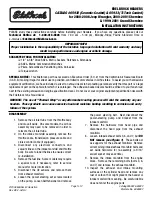
1051 & 1052 H & J
Instruction Manual
Form 5587
November 2006
5
and approximate weights in table 7.
This information is required for proper
fabrication of the user-provided
bracket and coupling.
1. For an actuator with an H mounting adaptation,
attach an appropriate mounting bracket (not
provided) to the mounting plate (key 22) with the cap
screws (key 78). See figures 4, 5, and 6 for
mounting dimensions on the mounting plate. Tighten
the cap screws to the bolt torques listed in table 10.
2. Consult figure 10 for available mounting styles
and positions. The actuator is normally positioned
vertically with the valve body or other equipment in a
horizontal pipeline.
Note
If the milled flats or the coupling on
the end of the actuator output shaft
(key 87) are oriented such that the
output shaft cannot accommodate the
operated equipment shaft, refer to the
Changing Positions portion of the
Changing Actuator Mounting section.
This procedure describes how the
output shaft can be repositioned to
accommodate the operated equipment
shaft.
3. If using an actuator with a J mounting adaptation,
note that the valve shaft coupling (key 90) is
furnished with two keyways lettered A and B as
shown in figure 8 and 12 (letters C and D on the
coupling are not used and can be disregarded).
Align the appropriate keyway with the keyway in the
operated equipment shaft. If using a Fisher butterfly
valve, align the appropriate keyway on the coupling
with the valve shaft keyway indicated in table 8.
Then install the woodruff key (key 91) in the shaft
keyseat, and slide the coupling onto the shaft. It is
helpful to apply a light coat of grease to the inside of
the coupling before sliding it onto the shaft.
4. For an actuator with an
H mounting
adaptation,
slide the actuator (with the user-provided mounting
bracket attached) into the user-provided coupling on
the operated shaft. Then, secure the actuator to the
operated equipment in the desired mounting position
with the appropriate fasteners, such as mounting
cap screws. See figures 4, 5 and 6 for output shaft
dimensions.
5. For an actuator with a
J mounting
adaptation,
secure the mounting bracket (key 22) to the valve
body with the cap screws (key 78, not shown).
Tighten the cap screws to the bolt torques in
table 10. For 31.8 and 38.1 mm (1-1/4 and 1-1/2
inch) valve shafts, also place the two spacers
(key 92, not shown) between the mounting bracket
and valve body during this step.
6. For an actuator with a
J mounting
adaptation
and a
50.8 mm (2-inch) output shaft
(key 87,
figure 14), note that the valve shaft coupling (key 90,
figure 14) is furnished with two keyways lettered A
and B as shown in figure 8 (letters C and D on the
coupling are not used and can be disregarded).
Align the appropriate keyway with the keyway in the
operated equipment shaft. Then, install the woodruff
key (key 91, not shown in figure 14) in the shaft
keyseat, and slide the coupling onto the shaft using
the appropriate coupling keyway (see table 8 and
figure 8). It is helpful to apply a light coat of grease
to the inside of the coupling before sliding it onto the
shaft. Secure the actuator (user-provided mounting
bracket) to the operated equipment in the desired
mounting position with the appropriate fasteners,
such as mounting cap screws.
7. Follow the instructions given in the Turnbuckle
Adjustment section before proceeding to the Loading
Connection portion of this section.






































